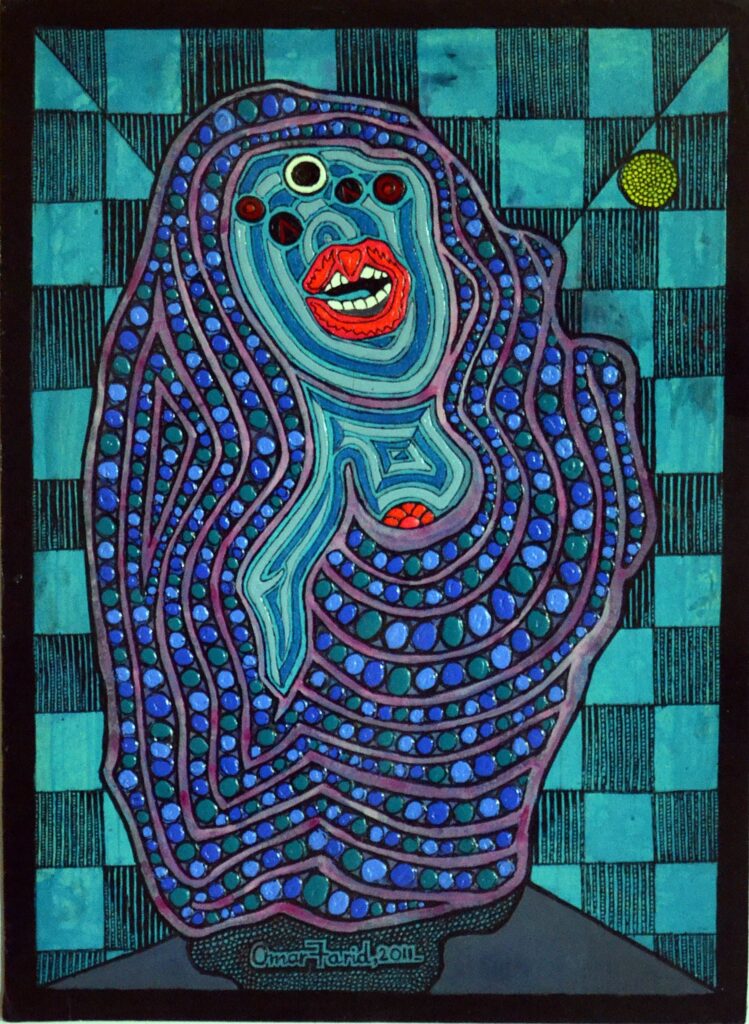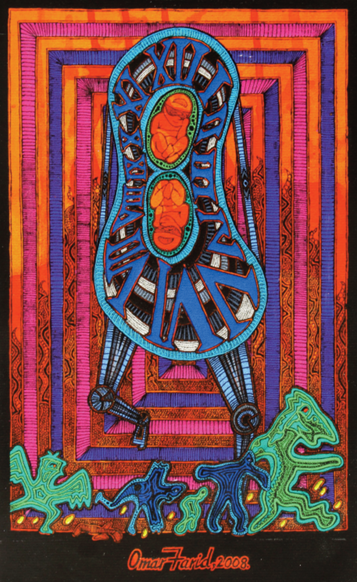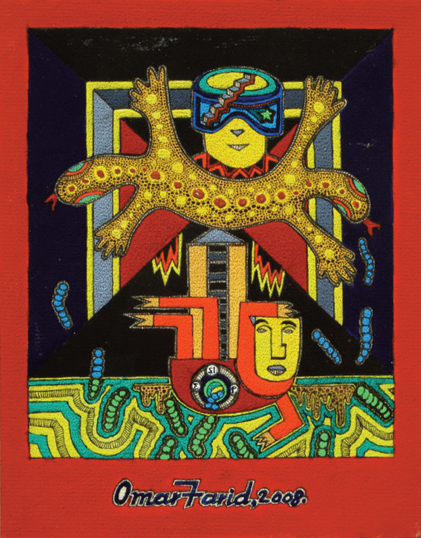By Dr. Arjumand Faisel
In early 2009, I arrived in Karachi for a meeting with the Sindh Health Secretary in my capacity as a Public Health Consultant. With a couple of hours to spare before the scheduled appointment, I opted to explore the Indus Gallery. Stepping into the gallery, I was captivated by the exhibition on display—a solo show by Omar Farid. It marked my inaugural encounter with his extraordinary works. The paintings before me spoke volumes of Farid’s intellect, showcasing a unique and mesmerizing blend of creativity and brilliance.
In my clinical practice, I encountered individuals experiencing hallucinations and the creatures, shapes and state they created and described were though formidable but were also often very interesting. Yet, when I beheld Omar Farid’s paintings, I couldn’t help but pondered that what condition of mental state and imagination birthed such striking elements, objects and figures and the overall compositions.
This prompted me to obtain Omar Farid’s phone number from Mrs. Shehnaz Imam and to immediately inquire if he could accommodate my visit to his studio. His affirmative response led me to inform him of my 1 pm appointment with the Health Secretary, which was expected to last for an hour. Hence, my expected visit time would be around 2.30 pm. His reply was unexpectedly blunt, advising me to prioritize between meeting him and the Health Secretary. He said “If you want to meet me, come now, but if you want to meet the Health Secretary then go and meet him … and don’t bother to come to me”.
Rather than feeling slighted, I found myself even more intrigued by him, thus agreeing to his terms. I managed to reschedule my appointment with the Health Secretary to 3:00 pm, allowing me the opportunity to visit Farid. His confident response, unconventional though it was, only fuelled my curiosity further. It’s not every day an artist refuses a visit from a gallery curator, but Farid’s candidness added to the allure of meeting him.
Omar himself greeted me at the gate, displaying the same eagerness to meet as I felt to encounter this distinct artist. Within moments, we were engrossed in conversation, exchanging thoughts in a friendly and cordial manner. He admired my decision to prioritize our meeting over my official engagement, for which I had travelled from Islamabad. During the tour of his home, he showcased all his available works. After indulging in over two hours of enriching dialogue, I departed with a profound admiration for his intellect and a mutual agreement to display his work at Gallery 6 in Islamabad.
The exhibition was scheduled in October 2009 and a few days before the exhibition, two individuals from agencies paid a visit to the Gallery. They conducted thorough inspections, asking numerous questions, and scrutinizing the entire premises, including entrances and exits. This prompted me to call Omar and inquire ‘who is he and is there any relationship of the agencies staff visit to his exhibition?’. He replied with a counter question, asking me if his response would have any effect on the show. Upon my assurance that the exhibition will proceed as planned and without any alterations, he disclosed, “I am Sehba Musharraf’s brother, and you know she is the President’s wife. She was considering attending the opening, but I have firmly advised her against it. Her presence might attract “chamchas” of the President who would purchase my paintings. I’d never be certain if my art is genuinely appreciated or merely bought to please the First Lady and the President. Rest assured, you won’t face any inconvenience.” This revelation only deepened my admiration for Omar. To my surprise, during the exhibition, he chose not to stay at the Presidential residence despite receiving calls from his sister. Instead, he lodged at a guest house opposite the Gallery in G-9 Sector. He also sought assurance from me not to disclose his association with the First Lady to any exhibition visitors.
Later, I discovered that during the opening of the PNCA, he purposely avoided staying at the Presidency to conceal his ties with the President. Instead, he opted to stay at a guest house and entered the event like any other guest, standing in line. Given the behaviours and norms of the privileged individuals prevalent in Pakistan, he could have easily sought the position of Director-General of the PNCA at that time. Alternatively, he could have sought to exhibit his paintings internationally or joined artists’ delegations travelling abroad. He also had the opportunity to navigate the system to secure the President’s Award for Pride of Performance. However, he deliberately abstained from seeking personal gain through any of these avenues.
Returning to the paintings of Omar Farid, which drew me to him. I must acknowledge that upon first encountering his fabulous creations, my immediate impression after looking at some of them was that he is probably working within the realm of anthropomorphism (the interpretation of nonhuman things or events in terms of human characteristics). I found parallels between some of his work and that of Wilfredo Lam, a Cuban painter (1902 – 1982) who resided in exile in Paris. The reminders were Wilfredo’s “Horse-Headed Woman” and several other untitled paintings done with hypnotically synthesized Cubism, Surrealism, and Primitivism. Also, this assertion was based on apparent fantasy, satire and critique in Omar’s works, as often practised by artists working in the arena of anthropomorphism.

“Blue Tease” by Omar Farid – 2011
“The Ides of March” by Omar Farid – 2008
This initial opinion was short-lived as I started to perceive Farid’s works as more reflective of an internalized existential state. I began to discern certain resemblances to the allegorical paintings of Bryan Charnley, a British artist who grappled with paranoid schizophrenia and delved into its effects in his art. I noticed some similarities in themes, design and color usage between Farid’s paintings and Charnley’s pieces such as “Queen Spanking Pawn”, “The Walk” and “Colour Garden” created in 1989 and 1990. However, Omar’s artworks are very well-defined having intricate details, which is visibly lacking in Charnley’s paintings.

“Gallery Blues” by Omar Farid – 2004
“The Ticktock Tic” by Omar Farid – 2008
However, Omar was certainly not schizophrenic, nor did he exhibit any symptoms of bipolar disorder. He was a man of principles, steadfastly adhering to them throughout his life, even when they proved challenging or disagreed with by others. I learnt that in one of his exhibition, a well-known collector requested a reduction in the price of a painting priced at Rs. 300,000. Omar’s response was characteristically different—he increased the price to Rs. 350,000 for the collector. Yet, I couldn’t help but wonder: could such unparalleled creativity stem from a strong ego and a tendency to live apart from social gatherings? I struggled to find another artist who could match the diversity of methods employed in Omar’s works. His oeuvre encompassed pointillism, geometric abstraction, intricate patterns of minuscule lines, shapes and forms, circles, squiggles as well as densely patterned ink-on-paper works- each characterized by an astonishing variety and attention to detail.

“Belladona” by Omar Farid – 1989
“Chrysalid: Mantisa” by Omar Farid – 2008
Another striking example of Omar’s artistic brilliance is the painting titled “Pentimenti,” derived from the Italian word ‘pentirsi,’ which also means to repent.
“Pentimenti” by Omar Farid – 2009
In this artwork, he presents a face with an expression open to myriad interpretations. The look created in abstraction is powerfully absorbing. The abstracted look is undeniably compelling, prompting contemplation on whether the face conveys feelings of hopelessness, restlessness, guilt, unworthiness, or helplessness. Alternatively, could it represent mental fatigue, an inability to focus or concentrate? Perhaps this state arises from chronic sleep disturbances or the aftermath of a traumatic shock? Additionally, the lines representing hair move distinctly in two directions: few single lines extending outward, while V-shaped double lines move inward in an aggressive manner, suggesting a surge of tension on the mind with inward pressure, with minimum output.
Such enigmatic artworks lead me to ponder about the state of trance Omar would enter while working in his studio. He persisted in creating art since the 1970s, with each piece distinct from the others, carrying its own narrative or significance, all presented in his iconic psychedelic style. In my fascination, I’ve coined the term “Halluginations” to describe this state of imagination and non-clinical hallucinations that resulted in magnificent artworks.
“Studio” by Omar Farid – 2005







([email protected])
Hi, how are you?
I am Elena Ammed. I believe a mutual relationship is a gradual process and as such, I am looking for a trustworthy man for a serious relationship. contact me directly at my email address
([email protected]) for us to get to know each other better, thanks.